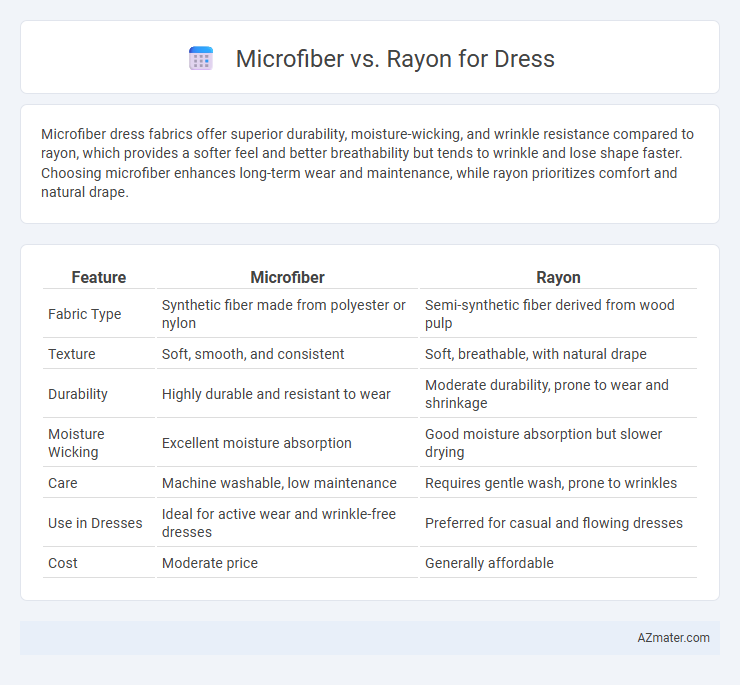Microfiber dress fabrics offer superior durability, moisture-wicking, and wrinkle resistance compared to rayon, which provides a softer feel and better breathability but tends to wrinkle and lose shape faster. Choosing microfiber enhances long-term wear and maintenance, while rayon prioritizes comfort and natural drape.
Table of Comparison
| Feature | Microfiber | Rayon |
|---|---|---|
| Fabric Type | Synthetic fiber made from polyester or nylon | Semi-synthetic fiber derived from wood pulp |
| Texture | Soft, smooth, and consistent | Soft, breathable, with natural drape |
| Durability | Highly durable and resistant to wear | Moderate durability, prone to wear and shrinkage |
| Moisture Wicking | Excellent moisture absorption | Good moisture absorption but slower drying |
| Care | Machine washable, low maintenance | Requires gentle wash, prone to wrinkles |
| Use in Dresses | Ideal for active wear and wrinkle-free dresses | Preferred for casual and flowing dresses |
| Cost | Moderate price | Generally affordable |
Introduction to Microfiber and Rayon
Microfiber is a synthetic fiber made from ultra-fine polyester or nylon strands known for its softness, durability, and moisture-wicking properties, making it a popular choice in dress fabrics. Rayon, a semi-synthetic fiber derived from cellulose in wood pulp, offers a smooth texture with excellent breathability and dye absorption, often used to create elegant, lightweight dresses. Both fibers provide distinct benefits in dressmaking, with microfiber excelling in wrinkle resistance and rayon valued for its natural feel and drape.
Understanding Microfiber: Composition and Properties
Microfiber, a synthetic fiber made from ultra-fine strands of polyester or nylon, offers superior softness, durability, and moisture-wicking properties compared to rayon. Its tightly woven structure enhances breathability and stain resistance, making it ideal for dress fabrics that require longevity and easy maintenance. Understanding microfiber's composition reveals why it excels in creating wrinkle-resistant, lightweight, and comfortable garments suitable for both casual and formal wear.
Rayon Explained: Source and Characteristics
Rayon is a semi-synthetic fiber made from cellulose derived primarily from wood pulp, notably from beech, pine, and spruce trees. Its production involves chemically treating natural fibers to create a soft, breathable material that mimics the feel of natural fabrics such as silk or cotton. Rayon is prized for its smooth texture, high moisture absorbency, and excellent drapability, making it a popular choice for dresses that require both comfort and elegance.
Comfort and Feel: Microfiber vs Rayon
Microfiber dresses offer a smooth, lightweight texture that feels soft against the skin and provides excellent moisture-wicking properties, making them ideal for all-day comfort. Rayon, known for its natural origin and breathability, delivers a silky feel with a fluid drape, enhancing comfort in warm climates by allowing better air circulation. Both fabrics prioritize softness, but microfiber excels in durability and wrinkle resistance, while rayon stands out for its natural, breathable comfort.
Durability and Care Requirements
Microfiber dresses offer superior durability due to their tightly woven synthetic fibers, resisting wrinkles, shrinking, and fading better than rayon. Rayon, made from natural cellulose fibers, tends to be more delicate, prone to stretching, shrinking, and color loss with frequent washing. Care for microfiber involves simple machine washing and low maintenance, while rayon requires gentle hand washing or dry cleaning to maintain fabric integrity.
Breathability and Moisture Management
Microfiber dresses offer superior moisture-wicking capabilities, drawing sweat away from the skin and allowing it to evaporate quickly, which enhances comfort during extended wear. Rayon, while breathable due to its natural cellulose fibers, tends to absorb moisture rather than wick it, which can leave the fabric damp and less comfortable in humid conditions. For optimal breathability and moisture management, microfiber is often preferred in active or warm climates, whereas rayon suits cooler environments where moisture absorption is less problematic.
Environmental Impact: Sustainability Comparison
Microfiber, typically made from petroleum-based synthetic fibers such as polyester or nylon, has a significant environmental impact due to its non-biodegradable nature and contribution to microplastic pollution in waterways. Rayon, derived from natural cellulose sources like wood pulp, is biodegradable but often involves chemically intensive processes that can harm ecosystems if not managed responsibly. Sustainable choices favor responsibly sourced rayon with eco-friendly production methods over conventional microfiber to reduce environmental degradation.
Cost and Affordability Factors
Microfiber dresses generally cost more than rayon due to advanced synthetic fiber production, but offer superior durability and wrinkle resistance, enhancing long-term affordability. Rayon dresses are typically cheaper upfront, making them a budget-friendly choice, though they may require more delicate care and have a shorter lifespan. Cost-effectiveness depends on balancing initial price with fabric performance and maintenance over time.
Style and Aesthetic Versatility
Microfiber offers a sleek, smooth texture that enhances modern dress designs with a polished, wrinkle-resistant finish, making it ideal for structured and tailored styles. Rayon provides a soft, natural drape and vibrant color absorption, lending itself well to flowing, elegant dresses with a more breathable and organic appearance. Both fabrics cater to diverse fashion aesthetics, but microfiber excels in durability and sheen, while rayon delivers superior comfort and fluidity.
Choosing the Best Fabric for Your Dress
Microfiber offers excellent durability, moisture-wicking properties, and wrinkle resistance, making it ideal for long-lasting, easy-care dresses. Rayon provides a soft, breathable texture with a smooth drape that enhances comfort and elegance, perfect for lightweight, flowy dresses. Choosing between microfiber and rayon depends on the desired dress function: opt for microfiber for active wear and longevity, or rayon for a breathable, luxurious feel.

Infographic: Microfiber vs Rayon for Dress
 azmater.com
azmater.com